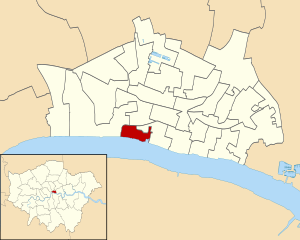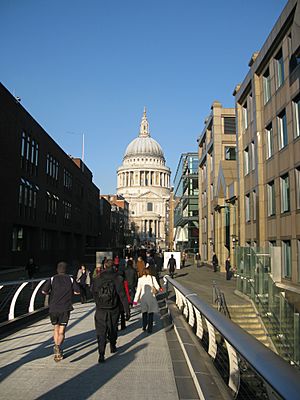Queenhithe facts for kids
Quick facts for kids Ward of Queenhithe |
|
|---|---|
 The Queenhithe riverside (upstream to the left; Queenhithe dock on right) from Bankside |
|
 Location within the City |
|
| Population | 319 (2011 Census. Ward) |
| OS grid reference | TQ321808 |
| • Charing Cross | 1.4 miles (2.3 km) West |
| Sui generis | |
| Administrative area | Greater London |
| Region | |
| Country | England |
| Sovereign state | United Kingdom |
| Post town | LONDON |
| Postcode district | EC4 |
| Dialling code | 020 |
| Police | City of London |
| Fire | London |
| Ambulance | London |
| EU Parliament | London |
| UK Parliament |
|
| London Assembly | |
Queenhithe is an old and small area, called a 'ward', in the City of London. It's right by the River Thames, south of St. Paul's Cathedral. The famous Millennium Bridge also connects to Queenhithe.
The name 'Queenhithe' also refers to an old dock, which isn't used anymore, and a small street next to it. Both are part of this ward. You can get to Queenhithe by London Buses route 4, which stops near the Millennium Bridge. The closest subway (London Underground) station is Mansion House.
Contents
The Story of Queenhithe
How Queenhithe Got Its Name
The name "Queenhithe" comes from "Queen's Dock" or "Queen's Quay." This dock was likely built by the Romans. Later, during Saxon times, it was called "Aeðereshyð" or "Ethelred's Hythe." This was around 886 AD, when Alfred the Great, a king of Wessex, rebuilt the City of London.
It became "Queenhithe" when Matilda, who was married to King Henry I, was given the right to collect taxes on goods brought into the dock. The Queenhithe dock is still there today, but it's not used anymore and is very muddy because of the tides.
What the Dock Was Used For
The Queenhithe dock was important for bringing corn into London. It was used for a long time, even into the 1900s, by businesses that worked with fur and leather. However, large sailing ships from the sea couldn't easily reach the dock anymore because of London Bridge.
A famous event happened here in 1666. King Charles II landed at Queenhithe during the Great Fire of London. He came to see the damage and help with putting out the fire. In 1973, the dock, its walls, and the street next to it were made a special protected site. It's the only old inlet left on the City's waterfront. Its walls have been made stronger to help protect London from floods.
Queenhithe During World War II
During the Blitz in World War II, about three-quarters of the buildings in Queenhithe were destroyed by bombs. Only a few historic buildings survived. These include St Benet Paul's Wharf Church and the tower of the old St Mary Somerset Church.
Queenhithe in Movies and Modern Times
A funny scene from the 1951 movie The Lavender Hill Mob was filmed in Queenhithe. In the movie, the character Mr. Holland, played by Alec Guinness, falls into the Thames and is rescued by actors pretending to be police officers.
The Millennium Bridge was built between 1998 and 2000. This footbridge made it much easier for people to walk from Bankside (where the Tate Modern art gallery is) to the St Paul's area. This has brought many more tourists and people commuting through Queenhithe.
Important Places in Queenhithe

Queenhithe has several important buildings and places:
- The Aviation Environment Federation's main office is at 2, Broken Wharf.
- The City of London School is at 107, Queen Victoria Street.
- The Salvation Army's international headquarters is at 101, Queen Victoria Street.
- The Painter Stainers' Hall is at 9, Little Trinity Lane.
- The Queenhithe Mosaic is at 1 Queenhithe.
Also in the ward are the London offices for the international law firm Salans and the Japanese bank Sumitomo Mitsui Banking Corporation.
The area of Queenhithe can be a bit confusing to navigate because of how it was rebuilt after World War II. Upper Thames Street runs under Peter's Hill, and there are many large buildings like Millennium Bridge House. Some old lanes and alleys still exist, and some even cross the main roads using footbridges.
The Welsh church of St Benet Paul's Wharf is in the northwest part of the ward. Two other churches, St Michael Queenhithe and St Mary Somerset, used to be very close to each other in the ward. Only the tower of St Mary's remains today.
The Queenhithe Mosaic
The Queenhithe Mosaic is a very long artwork, about 30 meters (98 feet) long, on the wall of Queenhithe Dock. It was finished in 2014. The mosaic shows a timeline of important people from history who built and used the dock or lived nearby.
Living in Queenhithe
Queenhithe is one of the few areas in the City of London where people live, as most of the City is for businesses. In 2011, about 319 people lived here. Most of them live in three buildings along the river: Sir John Lyon House, Globe View, and Queen's Quay. There are also a few bars and restaurants along the riverside, offering views of the Globe theatre and Tate Modern.
Queenhithe's Borders
Changes to the Ward's Boundaries
In 2003, the borders of the City of London's wards were changed quite a bit, including Queenhithe's. This was the first big review of local government borders. Queenhithe lost some land to the north and east to the Vintry ward. However, it gained some land to the west from Castle Baynard, including the City of London School.
Another review in 2013 suggested no more changes to Queenhithe's borders. Queenhithe is known as one of the four "residential wards" in the City. This means that the goal is to keep more residents living there, rather than having businesses be the main focus.
Where Queenhithe Is Today
The current border of Queenhithe starts at the Thames in the west. It goes north along White Lion Hill (west of the City School), then east along Queen Victoria Street, and then down Lambeth Hill. The border then runs a short distance along Upper Thames Street before heading north up Huggin Hill to include Painters' Hall. After that, the border turns south back towards the river. The ward includes all of Queensbridge House.
Leading to the river, the border crosses Upper Thames Street and then runs along Queenhithe (the street), including the entire old Queenhithe dock. The ward also includes the part of the Thames next to the Queenhithe shore that belongs to the City. About half of the ward's total area is actually the River Thames and its shore. If you don't count the river, Queenhithe is the smallest ward in the City by area. The ward's border also crosses the middle of the Millennium Bridge.
Queenhithe is next to the wards of Castle Baynard to the west, Bread Street to the north, and Vintry to the east. To the south, across the river, is the London Borough of Southwark. Before the 2003 changes, it was also next to the Cordwainer ward.
How Queenhithe Is Governed
Queenhithe is one of 25 wards in the City of London. Each ward chooses an alderman to be part of the Court of Aldermen. They also choose 'commoners' (like a Councillor) to be part of the Court of Common Council for the City of London Corporation. Only people who have been given the Freedom of the City of London can run for these positions.
Queenhithe chooses one Alderman and two Common Councilmen to represent it in the Corporation of London.
Queenhythe in Jamaica
There is a small community called Queenhythe (or Queen Hythe) in the Saint Ann area of Jamaica. Like many places in Jamaica, it is named after a place in England.



